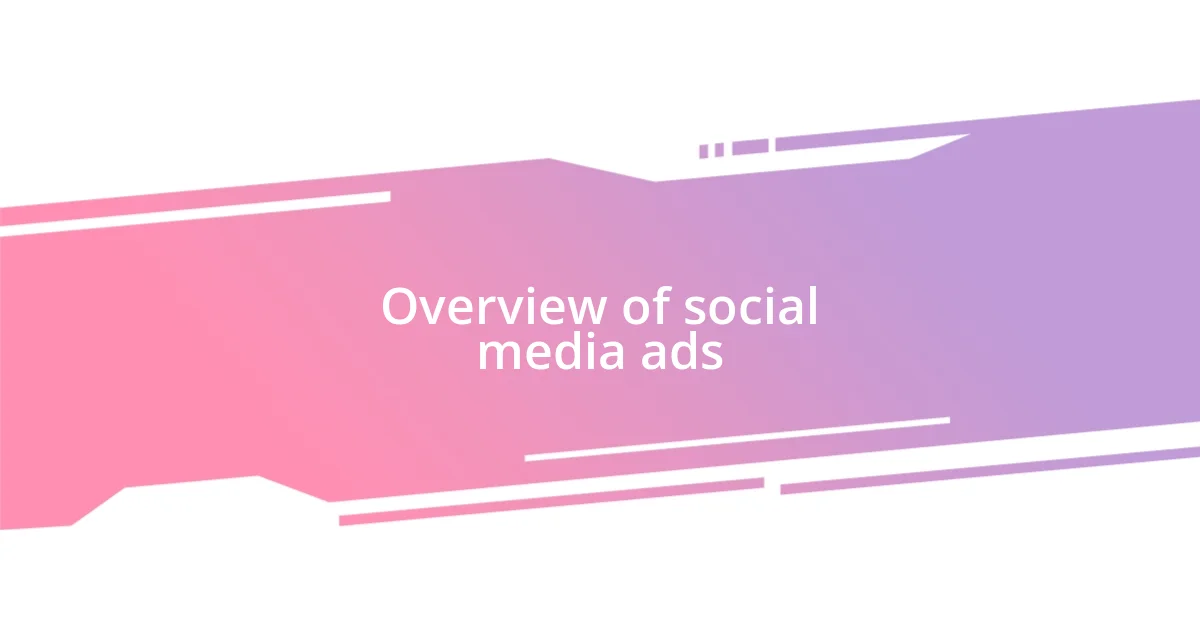Key takeaways:
- Social media ads enable targeted, personal engagement and creativity through various formats, with storytelling being a key element in successful campaigns.
- Choosing the right tools for social media ads is critical, focusing on usability, cost-effectiveness, and analytics capabilities to enhance campaign performance.
- Effective audience targeting through tools like Facebook’s Audience Insights and Google Ads Keyword Planner allows more strategic ad creation based on data-driven insights.

Overview of social media ads
Social media ads have become a cornerstone of digital marketing, captivating millions of users daily. They’ve transformed the way brands connect with their audiences, allowing for targeted messaging that feels personal. I often think about how, years ago, traditional advertising didn’t offer this kind of engagement—how many times did I overlook a billboard while scrolling through my phone?
Experimenting with different ad formats, from stories to carousel ads, has shown me just how versatile this medium can be. I remember launching a campaign that highlighted our product using a creative video ad, and the engagement rates skyrocketed. It made me wonder: how often do we underestimate the power of storytelling in advertising?
With advanced targeting options, I can reach specific demographics that truly resonate with my message, which makes me feel more connected to my audience. It’s gratifying to see how a well-placed ad can lead to genuine conversations and even community building. Have you experienced that thrill when an ad you created hits the mark? It’s a reminder of the unpredictable nature of social media advertising—sometimes, what you think will flop turns out to be a hit.

Key factors for choosing tools
When selecting tools for social media ads, it’s crucial to consider usability. A tool that is intuitive can save time and frustration, allowing me to focus more on creativity and strategy. I vividly recall trying a complex platform once—its steep learning curve made me question whether I wanted to continue. Simplicity truly enhances productivity in my experience.
Cost-effectiveness is another key factor. Budget constraints are omnipresent in advertising, and finding tools that offer robust features without a hefty price tag can be a game changer. I remember stumbling upon a budget-friendly tool that not only fit my needs but also provided unexpected insights into my audience’s behavior. It made me realize that the most expensive tool isn’t always the best.
Lastly, it’s essential to look at the analytics capabilities of the tools. After all, data-driven decisions lead to more successful campaigns. I’ve found that tools with comprehensive analytics can transform a good campaign into a great one by revealing what works and what doesn’t. Reflecting on my own experiences, I often think about how insightful data can refine future strategies and ultimately drive better results.
| Factor | Description |
|---|---|
| Usability | The ease of use of the tool, impacting efficiency and creativity. |
| Cost-effectiveness | The price versus features offered, crucial for budget management. |
| Analytics Capabilities | The depth of data provided for informed decision-making. |

Essential tools for ad creation
Creating compelling ads requires the right tools to transform ideas into impactful visuals. I can’t emphasize enough how essential design software like Canva or Adobe Spark has been for me. Last month, I used Canva to whip up a striking ad in less than an hour, and it really got my creative juices flowing. That rush of seeing a concept take shape is something I’m sure many of you can relate to when you finally nail that design.
- Canva: User-friendly interface for quick design with templates and elements.
- Adobe Spark: Great for dynamic visuals and videos with a professional touch.
- Crello: Offers animation and graphics to make ads pop.
Ad copywriting tools are equally important. I remember feeling overwhelmed by the pressure of crafting perfect copy, but tools like Copy.ai have turned that around for me. By generating catchy phrases in seconds, it takes a weight off my shoulders, allowing me to focus on strategy rather than getting stuck in the wording trenches.
- Copy.ai: Generates engaging ad copy with a few keywords.
- Jasper: AI-driven insights to refine and enhance messaging.
- Grammarly: Ensures error-free and polished text before launching.

Best tools for ad management
When it comes to ad management, selecting the right tools can really streamline the entire process. One tool I’ve found invaluable is Hootsuite, which not only helps in scheduling posts but also allows me to manage multiple platforms from one dashboard. I remember the chaos I faced manually posting on different sites—talk about time-consuming! With Hootsuite, I can set everything up in advance and focus on creating rather than scrambling to publish on the fly.
Another essential tool is AdEspresso. This platform has taught me so much about A/B testing ads effectively. I initially felt overwhelmed by the idea of running multiple variations, but AdEspresso simplifies it all. It’s fascinating how just tweaking a headline or image can dramatically alter engagement rates—I often think about how a small change can yield big results in the long run.
Lastly, I can’t overlook the power of Facebook Ads Manager. While it may seem daunting at first, I’ve come to appreciate its detailed analytics and targeting options. There was a time when I felt lost sifting through metrics that seemed irrelevant, but now, I view it as a treasure trove of information. Have you ever had that moment where a data point clicks, and suddenly everything makes sense? That’s the magic of leveraging the right ad management tools!

Analyzing performance with tools
Tracking the performance of your social media ads can be a game-changer. I remember when I first started analyzing my campaigns; I felt like a detective piecing together clues. Tools like Google Analytics and social media insights give me the data I need to understand what’s working and what’s not. I often catch myself blending numbers into my strategy—it’s like turning abstract figures into actionable steps that drive future campaigns.
One tool that has become essential for me is Sprout Social. The first time I delved into their reporting features, it was eye-opening. Seeing engagement metrics and audience demographics laid out clearly helped me tailor my approach for different platforms. Have you ever looked back at your content and wished you could tweak it based on real feedback? I felt a mix of excitement and relief when I could refine my strategy, knowing I was creating ads that truly resonate.
Finally, I can’t stress enough the importance of visualizing your data. Dashboards from platforms like Tableau make this possible. The first time I turned raw data into vibrantly colored graphs, I was hooked. It transformed the way I looked at performance—it was no longer just a list of numbers but a story waiting to be understood. Don’t you think a visual representation can make it so much easier to grasp complex data? Understanding your ad performance doesn’t have to be overwhelming; it can actually be incredibly enlightening!

Tools for audience targeting
When it comes to audience targeting, I can’t overstress the importance of utilizing tools that help you hone in on your ideal customers. One tool that has really stood out for me is Facebook’s Audience Insights. It’s fascinating to dig into demographics, interests, and behaviors; I often find myself saying, “Wow, I never thought my audience would be so varied!” Gaining that understanding ultimately shapes how I tailor my ads to reach the right people more effectively.
Another tool that has significantly improved my targeting is Google Ads Keyword Planner. I remember the first time I used it—my mind was blown by the keyword ideas and search volumes it revealed. Have you ever felt like you were just guessing what your audience wanted? I used to throw darts at a board, but with data-driven insights from this tool, I now craft ads that truly resonate with what people are actively searching for.
And let’s not forget about the power of Lookalike Audiences on platforms like Facebook. This feature has changed the game for me. In the beginning, I was hesitant to expand beyond my existing customers. But when I finally tried creating a Lookalike Audience based on my best clients, it was like turning on a light in a dark room. Suddenly, I found potential customers who mirrored my existing audience, making my targeting efforts feel less like a shot in the dark and more strategic. Isn’t it exciting to think about all the potential connections just waiting to be made?













